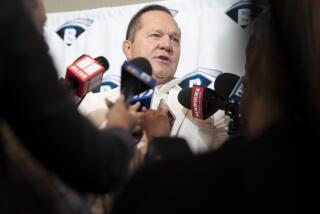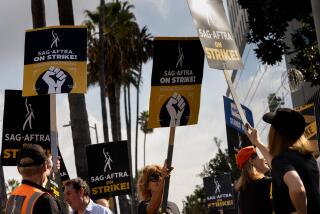BASEBALL ‘94: Going, Going. . .Gone : Strike Chronology
- Share via
1992
Dec. 7: Owners vote 15-13 at Louisville, Ky., to reopen collective bargaining agreement as of Jan. 10 in sections on free agency, salary arbitration and minimum salary.
Dec. 8: Owners send notices to Federal Mediation and Conciliation Service and the New York State Mediation Board that they may lock out players after 60-day window.
1993
Jan. 13: Talks begin with Richard Ravitch president of the owners’ Players Relations Committee, announcing he will recommend to owners that there be no lockout during 1993.
Jan. 25: Sides meet for four hours, with Ravitch expanding on his view of the industry’s economic condition.
Aug. 12: Owners pledge not to lock out players during the 1994 season and not to unilaterally change terms of the collective bargaining agreement through the conclusion of the 1994 season.
Dec. 31: Collective bargaining agreement expires.
1994
Jan. 18: Owners agree to a new revenue sharing formula among themselves but condition it on players agreeing to a salary cap.
March 7: Talks resume in Tampa, Fla., with Ravitch addressing about 75 players.
March 30: Ravitch talks to about 50 players at Phoenix airport hotel.
May 23: Ravitch proposes eliminating termination pay, trade demands and major league service for players called up in September.
June 14: Owners make salary- cap proposal, asking players to split revenue 50-50 in exchange for limiting payrolls to 84% -110%. Owners propose to eliminate arbitration but lower free-agent eligibility to four years of service from six -- with the provision that a player’s former club can match any offer until he has six years of service.
July 18: Players reject salary-cap proposal and ask owners to lower threshold for arbitration to two years, eliminate restriction on repeat free agency within five years and raise minimum to $175,000-$200,000.
July 27: Ravitch rejects players’ proposals.
July 28: The union’s executive board votes unanimously to set an Aug. 12 strike date.
Aug. 12: Strike begins after another bargaining session. Both sides agree to federal mediation.
Aug. 18: Mediators announce owners will come to bargaining table.
Aug. 24-25: Two days of bargaining fail to produce movement.
Aug. 31: Union head Donald Fehr and his brother, Steve, a union advisor, meet secretly with Colorado Rockies owner Jerry McMorris and management lawyer Chuck O’Connor.
Sept. 2: Acting commissioner Bud Selig announces tentative Sept. 9 deadline for canceling the season if there’s no agreement. Owners provide additional revenue-sharing date to the union.
Sept. 7: Bargaining teams return to New York. McMorris, Boston Red Sox CEO John Harrington, Milwaukee Brewers vice president Wendy Selig-Prieb and O’Connor meet secretly for three hours with Fehr brothers and union lawyers Eugene Orza and Lauren Rich.
Sept. 8: Players present a proposal calling for 1 1/2% “tax” on revenues and payrolls of the 16 largest clubs by revenue and payrolls -- money that would be distributed to the bottom 12 in each category. It also calls for home teams to share 25 % of their gate receipts.
Sept. 9: Selig announces that the owners have rejected the players’ offer, but postpones canceling the rest of the season.
Sept. 14: Owners cancel the World Series for the first time since 1904.
Other Strike Years
With dates of settlement
1972
April 1--April 13: Players and owners settle on a four-year pension plan agreement. 86 games postponed by the strike are not rescheduled. The season opens April 15. Result: Salary arbitration for players with more than two years’ service.
1973
Feb. 8--Feb 25: Owners refuse to allow spring training to be held without a collective-bargaining agreement. No games are affected. Result: Three-year agreement that establishes salary arbitration for players with two or more years of major league service.
1976
March 1--March 17: Owners refuse to start spring training as scheduled on March 1 until a new agreement is reached. On March 17, Commissioner Bowie Kuhn orders training camps opened. Result: On July 12, players and owners reach a four-year agreement that established procedure for free agency. Players with at least six years service may become free agents but then must wait five years before becoming a free agent again.
1980
April 1--April 8: Players strike final eight days of spring training, forcing cancellation of 92 exhibition games. Result: Players and owners reach a four-year agreement but allow the issue of free agency to be reopened during the following season.
1981
June 12--July 31: Players stage first midseason strike in baseball history. The strike ends after 50 days and 712 canceled games. Result: Agreement extends existing contract one year through Dec. 31, 1984. Season restars after All-Star game. Division winners of the first half play division winners of the second half in the first-ever divisional playoffs.
1985
Aug. 6--Aug. 7: After a two-day strike, players and owners reach a five-year agreement. Result: Salary arbitration eligibility is increased from two to three years. The 25 strike-affected games are made up.
1990
Feb. 15--Mar. 18: Owners lock the players out of spring training. Result: Agreement is reached on a four-year contract. Season starts on April 9, a week behind schedule. The 78 games postponed by the lockout are rescheduled.
More to Read
Go beyond the scoreboard
Get the latest on L.A.'s teams in the daily Sports Report newsletter.
You may occasionally receive promotional content from the Los Angeles Times.










